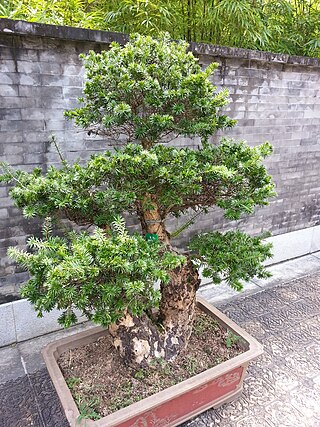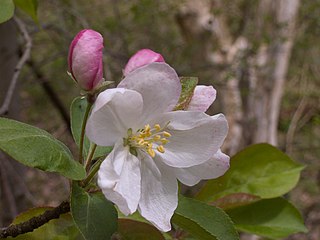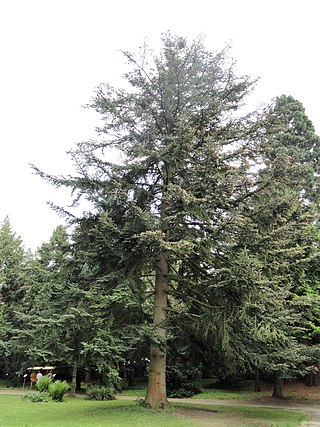
Ptelea trifoliata, commonly known as common hoptree, wafer ash, stinking ash, and skunk bush, is a species of flowering plant in the citrus family (Rutaceae). It is native to North America, where it is found in Canada, Mexico, and the United States. It is a deciduous shrub or tree, with alternate, trifoliate leaves.

Cercis canadensis, the eastern redbud, is a large deciduous shrub or small tree, native to eastern North America from southern Michigan south to central Mexico, west to New Mexico. Species thrive as far west as California and as far north as southern Ontario. It is the state tree of Oklahoma. The prevalence of the so-called "Columbus strain" has seen the residents of Columbus, Wisconsin embrace the plant into their city's identity. Known as the "Redbud City," the town hosts "Redbud Day" annually the Saturday before Mother's Day, organizing a variety of themed events to recognize the tree.

Nothotsuga is a genus of coniferous trees in the family Pinaceae endemic to China. Nothotsuga contains only one species, Nothotsuga longibracteata, commonly known as the bristlecone hemlock, which is found in southeastern China, in southern Fujian, northern Guangdong, northeast Guangxi, northeast Guizhou, and southwest Hunan.

Keteleeria is a genus of three species of coniferous trees in the family Pinaceae first described as a genus in 1866.

The Fraser fir, sometimes spelled" Frasier fir, is an endangered species of fir native to the Appalachian Mountains of the Southeastern United States. They are endemic to only seven montane regions in the Appalachian Mountains.

Pinus hwangshanensis, or Huangshan pine, is a species of pine endemic to the mountains of eastern China; it is named after the Huangshan Mountains in Anhui, from where it was first described.

Abies sibirica, the Siberian fir, is a coniferous evergreen tree native to the taiga east of the Volga River and south of 67°40' North latitude in Siberia through Turkestan, northeast Xinjiang, Mongolia and Heilongjiang.

Keteleeria fortunei is a coniferous evergreen tree. Originated in China, K. fortunei is an ancient relict species and a second-class national key protected plant, "mainly distributed in south subtropical to the middle subtropical edge". It is found in the provinces of Fujian, Guangdong, Guangxi, Guizhou, Hunan, Jiangxi, Yunnan, and Zhejiang. The tree grows in hills, mountains, and broadleaf forests at elevations of 200–1400 m. The lifespan of K. fortunei can reach more than a thousand years, and the height of a thousand-year-old tree can reach more than 40 meters. "Economically, K. fortunei is a treasure, and its comprehensive development and uses has broad prospects". The species is named after Scottish botanist Robert Fortune, who discovered the tree in 1844. K. fortunei has also been reported from Vietnam but this is attributed to misidentification of immature specimens of Pseudotsuga sinensis.

Larix griffithii, the Sikkim larch, is a species of larch, native to the eastern Himalaya in eastern Nepal, Sikkim, western Bhutan and southwestern China, growing at 1,800–4,100 metres (5,900–13,500 ft) in altitude.

Catalpa bignonioides is a short-lived species of Catalpa that is native to the southeastern United States in Alabama, Florida, Georgia, Louisiana, and Mississippi. Common names include southern catalpa, cigartree, and Indian-bean-tree. It is commonly used as a garden and street tree.

Cladrastis kentukea, the Kentucky yellowwood or American yellowwood, is a species of Cladrastis native to the Southeastern United States, with a restricted range from western North Carolina west to eastern Oklahoma, and from southern Missouri and Indiana south to central Alabama. The tree is sometimes also called Virgilia.

Pinus massoniana is a species of pine, native to Taiwan, a wide area of central and southern China, and northern Vietnam.

Tsuga chinensis, commonly referred to as the Taiwan or Chinese hemlock, or in Chinese as tieshan, is a coniferous tree species native to China, Taiwan, Tibet and Vietnam. The tree is quite variable and has many recognised varieties, though some are also maintained to be separate species by certain authorities. The tree was recently discovered in the mountains of northern Vietnam, making that the southernmost extension of its range.

Malus coronaria, also known by the names sweet crabapple or garland crab, is a North American species of Malus (crabapple).

Abies chensiensis, the Shensi fir, is a fir native to Gansu, Hubei, Sichuan, Tibet, Yunnan in China, and Arunachal Pradesh in India. It was first described by Philippe Édouard Léon Van Tieghem in 1892.

Paris polyphylla is an Asian species of flowering plant native to China, the Indian Subcontinent, and Indochina. It produces spider-like flowers that throw out long, thread-like, yellowish green petals throughout most of the warm summer months and into the autumn. In the fall, the flowers are followed by small, scarlet berries. It is a perennial, which slowly spreads, is fully hardy in Britain, and survives in leafy, moist soil in either complete or partial shade.

Zelkova serrata is a species of the genus Zelkova native to Japan, Korea, eastern China and Taiwan. It is often grown as an ornamental tree, and used in bonsai. There are two varieties, Zelkova serrata var. serrata in Japan and mainland eastern Asia, and Zelkova serrata var. tarokoensis (Hayata) Li on Taiwan which differs from the type in its smaller leaves with less deeply cut serration on the margins.

Cadaba aphylla ("Swartstorm") is one of the many species in the genus Cadaba. It is indigenous to southern Africa.

Itoa orientalis is a species of flowering plants belonging to the family Salicaceae. An evergreen tree from China and Vietnam, and cultivated as an ornamental tree.
Zanthoxylum dissitum is a woody plant native to China. It grows in upland thickets and open forests, forests, at 300-2600 m altitude.




















